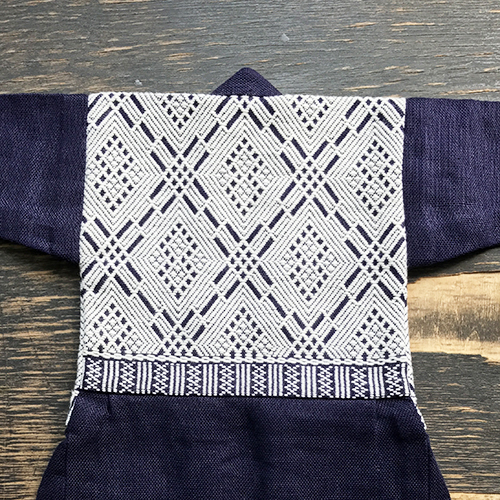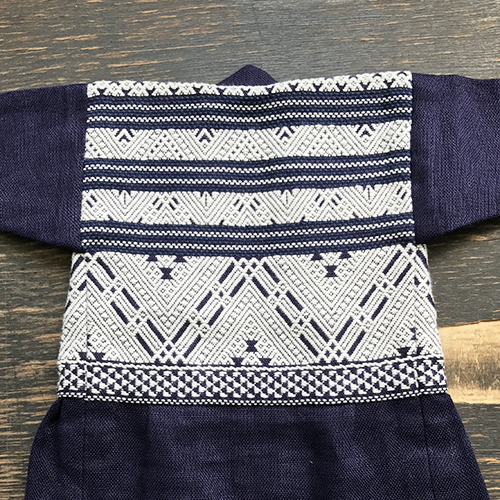◆Origin◆

"Tsugaru, southern part of Sashikogi" (edited · published, reprinted from Minzokumingu laboratory)
During the Edo era, the Tsugaru farmers were not allowed to wear clothing other than clothes made out of hemp. In order to overcome the Tsugaru’s brutal and very long winter comfortably. the purpose for moisturizing and reinforcement, people began to sew with cotton thread to to the clothes, and eventually "Tsugaru-Kogin Sashi" was born. “Tsugaru-Kogin Sashi” is a technique to pierce the odd counts 1, 3, 5, 7,,,. against the vertical weave.Developed mainly in Hirosaki.
◆Record of History◆
Masumi Sugae's "Yuran Ki" who traveled all over the Tohoku region during the Edo era and wrote about the lives and customs of the people lived in the area. He said that "Men and women living in mountain villages around the Kuroishi, they wore clothing called Shiso, mountain shiso, which is short clothing with a variety of patterns on it and it was “Sashi Koginu” "(transliteration) appears in “Yuran Ki.”
In addition, Tenpo Era (1788), Sadahiko Hirano recorded in a pictorial form in the episode "Ouminzui".


◆Types and Characteristics of “Kogin-Sashi”◆
East Kogin
From the Iwaki River, Hirosaki City where the castle was located, east side, Kuroishi City, Hirakawa City, Ishikawa area in Hirosaki City. The “Kogin-Sashi” in the east side were sewed with rough and thick hemp yarn, and had a same pattern from front to back.

West Kogin
In the Satoyama area such as Hirosaki-shi, Nishi-ya village, Hirosaki-shi Iwaki district, Hirosaki-shi Soma area, and across the Iwaki River. Because it was stabbed with a cloth woven with thin thread, it has very dense pattern. In the shoulder part there is a stripe sewed alternately with black and white thread, so it is also called "Shima Kogin".

Mishima Kogin
“Mishima Kogin” was made centered around Old Kanagi Town (current Goshogawara-shi) which is the downstream of the Iwaki River and Old Shariki village and Kizukuri town (current Tomoni Tsugaru-shi). It features three bright striped patterns. There are very few existing and they are very valuable.

“Modoko”
The basic pattern of “Kogin-Sashi” is called "Modoko" and there are about 40 kinds currently. By combining “Modko”, a bigger and more beautiful geometric patterns are created.

- 1. Kacharazu
- 2. Mameko
- 3. Hanako
- 4. Ishidatami
- 5. Musubibana
- 6. Shimaibishi
- 7. Shimadasashi
- 8. Hukube
- 9. Komakurasashi
- 10. Uroko shape
- 11. Hukube
- 12. Cat’s foot
- 13. Cat’s manag
- 14. Tekona
- 15. Yasukosashi
- 16. Mamekoyotsukogori
- 17. Urokogata
- 18. Kurubikara
- 19. Bekozashi
- 20. Umano Kutsuwa
- 21. Saya shape
- 22. Continuous Mameko
- 23. Takeno Hushi
- 24. Takeno Hushi
